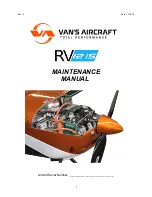
Zlin Aviation
Section 2
Maintenance Manual Line Maintenance, Repairs and Alterations
Issued: 01/02/2006
QAP-AMM-Rev02
Date of latest Revision: 23/01/2013
Page Number: 2-15
affected area by hand, using a soft clean cloth dampened with a mixture of turpentine and chalk, or
by applying automobile cleanser with a damp cloth. Remove the cleaner and polish with a soft, dry
cloth. Acrylic and cellulose acetate plastics are thermoplastic. Friction created by buffing or
polishing too long in one spot can generate sufficient heat to soften the surface. This condition
will produce visual distortion and should be avoided.
REPLACEMENT PANELS.
Use material equivalent to that originally used by the manufacturer
of the aircraft for replacement panels. There are many types of transparent plastics on the market.
Their properties vary greatly, particularly in regard to expansion characteristics, brittleness under
low temperatures, resistance to discoloration when exposed to sunlight, surface checking, etc.
Information on these properties is in MIL-HDBK-17A, Plastics for Flight Vehicles,
Part II Transparent Glazing Materials, available from the Government Printing Office (GPO).
These properties are considered by aircraft manufacturers in selecting materials to be used in their
designs and the use of substitutes having different characteristics may result
in subsequent difficulties.
Contact ZA for detailed specifications on materials used on Savage Aircrafts.
INSTALLATION PROCEDURES.
When installing a replacement panel, use the same mounting method employed by the manufacturer
of the aircraft. While the actual installation will vary from one type of aircraft
to another, consider the following major principles when installing any replacement panel.
Never force a plastic panel
out of shape to make it fit a frame. If a replacement panel does not fit
easily into the mounting, obtain a new replacement or heat the whole panel and reform. When
possible, cut and fit a new panel at ordinary room temperature.
In clamping or bolting plastic panels
into their mountings, do not place the plastic under
excessive compressive stress. It is easy to develop more than 1,000 psi on the plastic
by over-torquing a nut and bolt. Tighten each nut to a firm fit, then back the nut off one full
turn (until they are snug and can still be rotated with the fingers).
In bolted installations,
use spacers, collars, shoulders, or stop-nuts to prevent tightening the bolt
excessively. Whenever such devices are used by the aircraft manufacturer, retain them in the
replacement installation. It is important that the original number of bolts, complete with washers,
spacers, etc., be used. When rivets are used, provide adequate spacers or other satisfactory means to
prevent excessive tightening of the frame to the plastic.
WINDSHIELD REPAIR
Minor Repairs.
There are times, however, when a windshield may be cracked and safety is not
impaired. In that case, repairs can be made by stop-drilling the ends of the crack with a # 30 drill
(1/8 inch) to prevent the concentration of stresses causing the crack to continue. Drill a series of
number 40 holes a half-inch from the edge of the crack about a half-inch apart, and lace through
these holes with brass safety wire (see figure 3-24) and seal with clear silicone to waterproof.
Temporary Repairs.
One way to make a temporary repair is to stop-drill the ends of the crack, and
then drill number 27 holes every inch or so in the crack. Use AN515-6 screws and AN365-632 nuts
with AN960-6 washers on both sides of the plastic. This will hold the crack together and prevent
further breakage until the windshield can be properly repaired or replaced.
Permanent Repairs.
Windshields or side windows with small cracks that affect only the
ppearance rather than the airworthiness of a sheet, may be repaired by first stop-drilling the ends of
the crack with a # 30 or a 1/8-inch drill. Then use a hypodermic syringe and needle to fill the crack
with polymerizable cement such as PS-30 or Weld-On 40, and allow capillary action to fill the
crack completely. Soak the end of a 1/8-inch acrylic rod in cement to form a cushion and insert it in











































